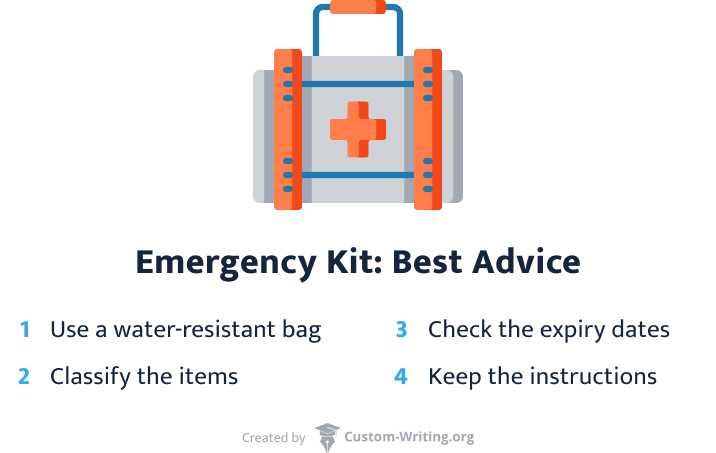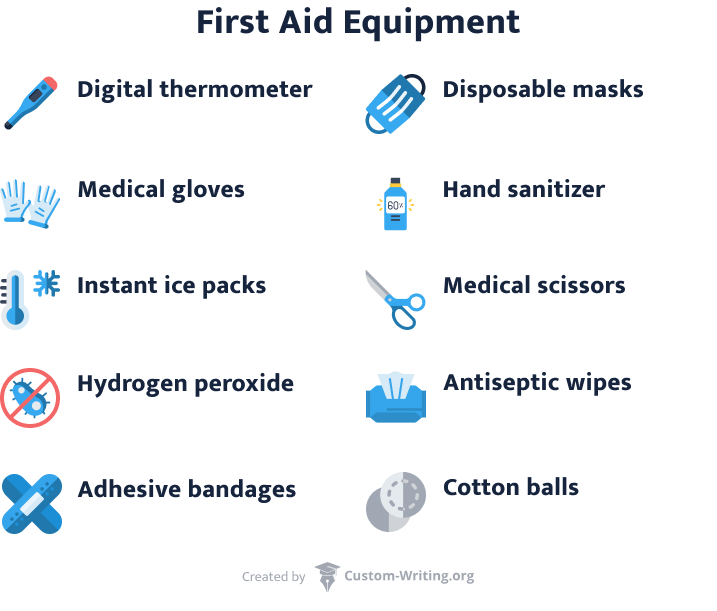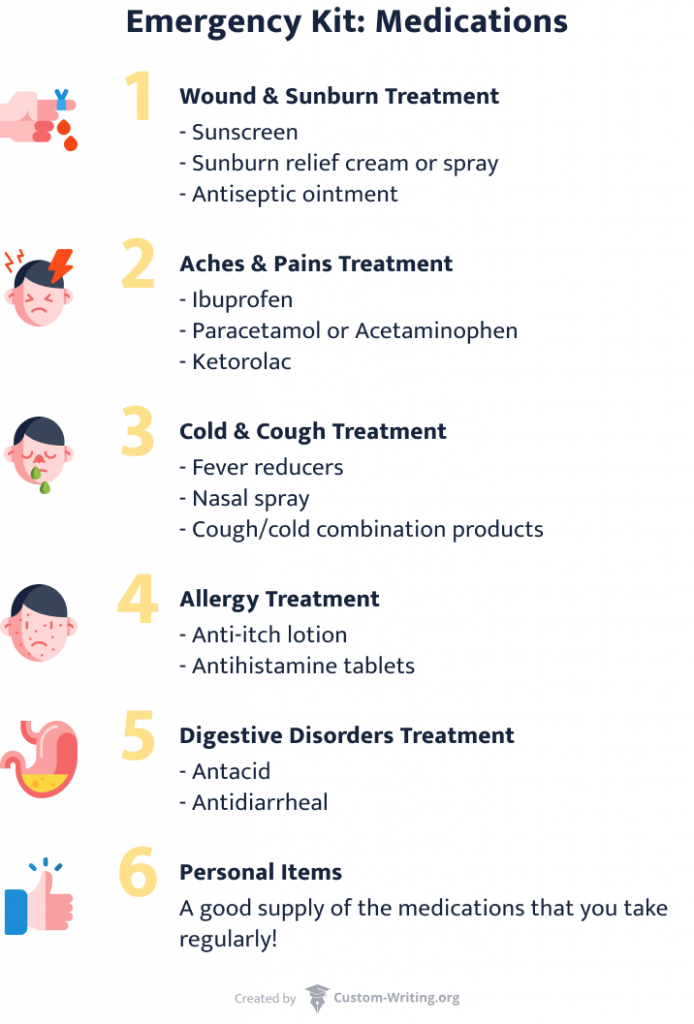You’ve probably seen a first aid kit in your parents’ car, a public institution, or a movie. Surprisingly, very few people know much about its contents, apart from Band-Aids. Custom-Writing.org experts are here to tell you that in stressful situations, you need to know how to use that first aid kit!
This article describes:
- what’s inside a college first aid kit
- why you need it
- how to use it
Here you will learn how the box should look, what first aid equipment you should put in it, and which medications you should include for any health conditions.
How to Pack a First Aid Kit
If you’re wondering how to pack a college emergency kit, we’ve got great tips for you.

- The best format for your kit is a water and impact-resistant bag. It doesn’t need to be an expensive one. For example, a make-up case would do fine.
- You can use plastic bags to classify the items. Group them by purpose: supplies for wounds, pain treatment, cold and cough medications, etc.
- Once every couple of months, check the expiration dates of the medical items.
- Keep all the product instructions inside the emergency kit. Alternatively, you can create a brief list of medicines in the form of a table with four columns: medicine name, indications, counterindications, and dosage. Setting up this chart takes time, but when you need it, the list is indispensable.
- The documents listed below should always be in the emergency kit:
- Your doctor’s contact details
- Your health insurance details (telephone number, insurance number, and copy of insurance card)
- Contact details for your Campus Health Service
- Emergency contact details (telephone numbers of parents, friends, or relatives)
- First aid manual
- Your personal medical information (blood type, list of regularly taken medicines, drug intolerances, allergies, medical conditions, etc.)
First Aid Equipment
Some things may seem useless until an emergency strikes. Your university survival kit is one of those things. It is your material insurance for things that might never happen. Below you can find the list of the essentials for a home or dorm first aid kit.

- Digital thermometer
- Two disposable masks, which are critical during the COVID-19 pandemic, but can also be used in the case of a disaster when dust is in the air
- Disposable medical gloves to clean up bodily fluids or blood
- Hand sanitizer, to be used before and after the provision of first aid
- Instant ice packs to relieve the pain of bruises and bug bites
- Curved medical scissors to cut dressings and adhesive tape
- Hydrogen peroxide, the universal sanitizer
- Antiseptic wipes for dirty hands and wounds
- Many adhesive bandages of different sizes, including butterfly-shaped ones to hold a wide wound together
- Cotton balls to apply peroxide and clean a wound
Medications
What are the main health problems a student can have? We have prepared a list of the most widespread health conditions with the most appropriate first aid treatment. Remember to check the expiration date of any medication before taking it!

Wound & Sunburn Treatment
- Sunscreen. If you enjoy working on your assignments in the park, sunburns can be your worst enemies. Even if you find a quiet place under a shady tree, some UV light will penetrate its leaves. A couple of hours can be enough to suffer from sunburnt skin on your face and shoulders. Sunscreen protects you from some amount of UV radiation. Apply a fresh layer every 2-3 hours.
- Sunburn relief cream or spray. These creams cool and soothe burnt skin. Avoid heavy ointments since they trap heat and impede the skin from cooling down. It is better to use substances containing aloe vera because of its soothing nature. If your skin is reddish but does not ache, go ahead and use a relief cream since the pain can come later. Here are some product examples:
- Antiseptic ointment. You should apply this on wounds before dressing them. These disinfectant creams are useful for the treatment of burns, cuts, scrapes, and scalds. Some examples are Polysporine, Betadine, Povidone-Iodine ointment, and Panthenol. Please read the product instructions before applying them on open wounds.
Aches & Pains Treatment
- Ibuprofen (Advil, Dolormin, Motrin) is the best medication for swelling and pain after sports injuries. Ibuprofen limits the production of prostaglandins, which our bodies release in response to injuries and illnesses. These medications work well for headaches, menstrual cramps, dental pain, muscle aches, or arthritis.
- Paracetamol or Acetaminophen (Tylenol, Sudafed) are used to relieve pain and fevers. They lessen the intensity of the pain signals traveling to the brain. They also prevent the release of substances (like prostaglandins) that make us feel pain and raise our body temperature. The drug is well tolerated at prescribed doses and is a popular over-the-counter pain reliever.
- Ketorolac (Toradol) reduces moderately severe pain, for example, toothaches or pain after surgery. It is a more powerful pain reliever than Ibuprofen or Paracetamol, so you should not use it for minor or chronic pain. It also works fast; 15 minutes after administration, the pain will begin to lessen, and the effect can last up to 6 hours. You should not take it for an extended period of time due to its side effects.
Cold & Cough Treatment
- Fever reducers (Paracetamol, Ibuprofen) have been mentioned above as pain reducers, but they are also effective against fever and cold symptoms. Prostaglandins tell the brain that something is wrong with the body, and the brain raises the body’s temperature in response to their presence. Fever reducers block these substances so that the brain stops raising the body’s temperature.
- A nasal spray is a liquid medicine you apply to your nose if it is running or blocked. All nasal sprays for people with colds can be divided into two groups:
- Saline sprays (Simply Saline, Walgreens) are salt-water solutions that loosen up the mucus and prevent congestion. These sprays contain no medications. Use them as often as you need.
- Decongestants (Vicks Sinex, Afrin) make your blocked nose breathe again. Dilated blood vessels in the nose cause congestion. These sprays narrow the blood vessels, reducing inflammation and swelling. Use them strictly according to the instruction.
- A cough/cold combination product (Delsym, FluTuss XP) relieves cough caused by hay fever, cold, or influenza. This medicine does not work for chronic coughs due to smoking, emphysema, or asthma. The product contains more than one active substance, for example, an analgesic, decongestant, and antihistamine. Be sure to read the drug formula to know whether or not it will work for your symptoms.
Allergy Treatment
- Anti-itch lotion (Sarna, Cerave) is a fast-acting treatment for dry and itchy skin. It soothes, moisturizes, and relieves itching due to insect bites, sunburn, sumac, or poison ivy. The lotion contains an antihistamine medicine and provides temporary relief.
- Antihistamine tablets (Allegra, Claritin) soothe the symptoms of allergies by blocking the effects of histamine (a substance involved in the local immune response to allergens). You should consult a doctor to prescribe the tablets that work best for you because each allergy is different. Antihistamine tablets of the latest generation have fewer side effects. You should take a pill only once a day.
Digestive Disorders Treatment
- Antacid (Maalox, Tums) reduces heartburn or indigestion by neutralizing the acid in your stomach. Over-the-counter variants do not have side effects for most people, but you should strictly follow the dosage.
- Antidiarrheal (Imodium, Kaopectate) medication is for watery, loose stool due to contaminated food and water or other causes. It slows down gut movement and decreases the number of bowel movements. But if diarrhea lasts for more than one day or the stool contains blood, you should consult a doctor.
Personal Items
Remember to have a good supply of the medications that you take regularly. If you have asthma, chronic migraines, or diabetes, we’re sure you know the list of the necessary drugs by heart. Unfortunately, in the case of an emergency, you might not be able to get to the drug store to buy them. The best way to prepare for such circumstances is to have everything you need in the first aid kit.
Useful Tips
Now that you know the most popular ways to treat everyday health problems, you might try to self-medicate. In doing so, you might find relief with simple aches and pains. But, in some cases, the following pieces of advice can save you from health deterioration and lengthy, expensive treatment.
- Always follow the instructions. Read the instructions before taking any medication. Take note of any possible counterindications and side effects.
- Never mix medicines with alcohol. These two substances should be consumed separately.
- Don’t use antibiotics unless prescribed. Many people take antibiotic drugs to treat most anything. However, you should never use them before consulting a doctor. Antibiotics are applicable only in some cases, and their side effects are numerous.
- Be careful. If you experience any of the following, you’ll need more than just your first aid kit: a fainting spell (even a brief one), bone fracture, damage to eyes or ears, suspected spinal injury, deep open wounds, or suspected COVID.
If your symptoms return every day, you may have a chronic illness. Even if the discomfort does not interfere with your normal life, recurrent symptoms can signal a more serious health problem. Visit a doctor so that they prescribe a thorough treatment.
We hope that after reading this article, you feel fully armed against sunburns, wounds, pains, colds, and allergies. The best thing you can do now is to go and fill up your college first aid kit with the essentials we have discussed above. If you can think of some medicines that we have missed here, please share your know-how in the comments below.

![Unexpected Career Tips from Celebrities [2026 Edition]](https://custom-writing.org/blog/wp-content/uploads/2021/01/Career-tips-title-1-284x153.jpg)






![Internship Essay: Example & Complete Writing Guide [2026]](https://custom-writing.org/blog/wp-content/uploads/2020/12/internship-student-e1565190155561-284x153.jpg)


![3 Scholarship Essay Examples about Yourself [2026]](https://custom-writing.org/blog/wp-content/uploads/2020/12/closeup-hand-student-holding-pencil-284x153.jpg)